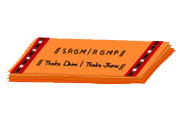Posted By: Administrator
Rāga: Hamsadhwani
Thāḷa: Chaturaśhra Eka
Composer: Tanjore Quartette
Language: Thamizh(Tamil)
Meaning – Word by word
Meaning-Overall: Team
Ambalam
Alignment, Diacriticals
& consequent spelling changes, Language & grammar editing, if any and
necessary, of existing meaning: Team Ambalam
|| Dhīm Dhīm Thakadhimi Dhimitha Dhimitha Kiṭa ||
|| Dhariguḍu Dharigugu Dhariguḍu Dhariguḍu ||
|| Thaddhīmtha Nakathari Kiṭa thaka Thaddhīmtha Thaddhīmtha ||
|| Thaṭavana Muni Jana Sakala Surāsura ||
|| Sannutha Pādha Kinkiṇi Jham Jham ||
|| Jhaṇa Jhaṇa Jhaṇa Jhaṇa Nūpura Laya Gathi ||
|| Khaṇa Khaṇa Khaṇa Khaṇa Vidhi Hari Sevitha ||
|| Thakkuḍu dhikkuḍu Thakathari Kiṭa thaka Thām Thatha ||
||thām thathaThakkiḍakiḍathaki Dharikiḍa Kiḍathaki||
||Thāṇḍa Dhigambara Dhikkiḍakiḍathaki Dhirikiḍakiḍathaki ||
||Vyāghra Charma Dhhara Thomkiḍa
Kiḍathaka Thonakiḍakiḍathaka ||
||Thriśhuladhhara Namkiḍakiḍathaki Namkiḍakiḍathaki ||
||Nandhi Vāhana Nādhayoga Priya
||
|| Jaganamkidathaki Jaganamkidathaki Dhirikiduthakka Thai ||
|| Jaga Jaga Jaya Jaya Śhaśhi Ravi Bhūṣhaṇa ||
|| Rūpa Bhayaṅkara Ḍamaruga Hastha ||
|| Thruthīya Sahasra Dhikṣhithanātha ||
||Nateśha Kauthvam – Repeat jaga jaga...upto kauthvam Twice ||
|| Thakathaka Thām Dhikidhiki Thai Thakku Dhikku Thakkiṭa Thām||
|| Than Dhan Dham Kiṭa thaka Dhiggitthām Thattha Thām ||
|| Tha Tha Thām.... Tha Tha Thām.. Tha Tha || Thām
Meanings:
Thaṭavana Muni Jana Sakala Surāsura
Thaṭavana - Dense Forest;
Muni Jana - The Ascetics
Sakala - Entire; Sura - Dhevas ; Asura – Asuras
Note: Vanam Means Forest. Thaṭavanam Refers To The Dhāruka Vanam
;
In the dense forest, the sages, the Gods and the demons,
Sannutha Pādha Kinkiṇi
Sannutha - Sung / Glorified / Praised
Pādha - Feet;
Kinkiṇi - The bells (here,of the anklet)
Praising the feet with bells of the anklets
Nūpura Laya Gathi
Nūpuram - Anklet
Laya Gathi - tempo & gait of the rhythm
Tempo & gait of the rhythm of the anklet.
Vidhi Hari Sevitha
Vithi - Brahma; Hari - Viṣhṇu;
Sevitha – Worshipped
Worshipped by Brahma and Viṣhṇu
Thāṇḍa Dhigambara
Thāṇḍa - One who performs the thāṇḍavam
Digambara - The space clad one
The space clad one who performs the thāṇḍavam.
Vyāghra Charmadhhara
Vyāghra - Tiger / Leopard;
Charma - Skin;
Dhhara - One who wears;
Triśhūladhhara - One who bears the trident;
Nandhi - One who has the bull; Vāhana –Vehicle
One who wears the tiger skin, bears the trident and has the bull for
his vehicle.
Nādha Yoga Priya
Nādha Yoga - music; Priya – fond
of;
One who is fond of nādha yoga
Jaya Jaya Jaya Jaya Śhaśhi Ravi Bhūṣhaṇa
Jaya Jaya - Hail / Victory / Praise
Śhaśhi - Moon;
Ravi - The Sun;
Bhūṣhaṇa – Oranament
One who has the sun & moon as his ornaments.
Rūpa Bhayaṅkara Ḍamaruka Hastha
Rūpa - Form;
Bhayaṅkara - Awesome
Ḍamaruka - The Drum; Hastha – Hand
One who has an awesome form and holds the Ḍamaru in his hand.
Note: I would prefer to say awesome, though it might mean
"fearsome", for can the divine create fear in you ever?? The Divine
is perceived as the terrible by those who are not ready (their ego's are too
small) or are not willing to accept (or take in) the overwhelming greatness of
the divine.
Thruthīya Sahasra Dīkṣhitha Nātha Nateśha Kauthvam
Thruthīya Sahasra – Three thousand;
Dhīkṣhitha – Ascetics; Nātha – Lord
of
Nateśha - Naṭānām Iśha - The Lord Of Dancers. Can
also be said as Naṭanam – Dance; Iśha – The Lord.
Naṭas - The practitioners of Nāṭya Vedha.
Kauthvam - prayer
This is the kautthuvam dedicated to the lord of the 3000 ascetics
who is also the lord of dance and dancers.
Note:
●
There
is an episode when the Dhīkṣhithas of Dhāruka vanam conjure up a tiger to
attack Śhiva - he kills the tiger, skins it, and wears the skin as his lower
garment - Just as the real tiger skin repels any insects, so does this light
repels any possible intrusions of the animal instincts and impulses.












